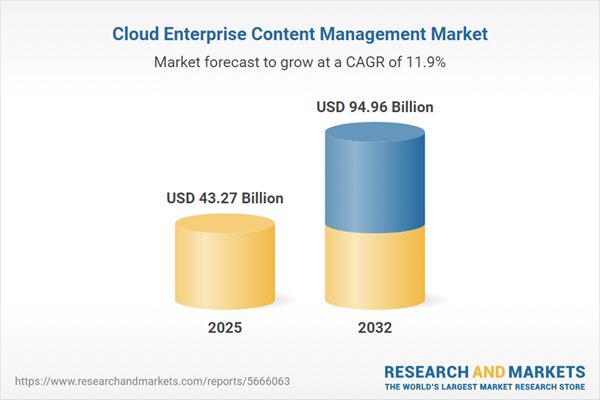Speak directly to the analyst to clarify any post sales queries you may have.
Cloud enterprise content management solutions are redefining how organizations approach secure data handling, regulatory compliance, and cross-team collaboration in the digital age. For senior decision-makers, cloud ECM provides a strategic lever for sustaining operational efficiency and supporting technology modernization.
Market Snapshot: Cloud Enterprise Content Management Market Overview
As of 2024, the global cloud enterprise content management market is valued at USD 38.62 billion and is projected to reach USD 43.27 billion by 2025, with a compound annual growth rate of 11.90%. This growth is driven by rapid adoption across industries such as banking, government, healthcare, and manufacturing. Evolving regulatory requirements, a stronger emphasis on information security, and transitions from outdated systems to scalable cloud-based solutions are expediting this upward trend. Companies in this sector shape their platforms around sector-specific compliance needs, workflow optimization, and strict content protection. These factors enable enterprises to advance digital transformation initiatives and adapt quickly to new compliance mandates, reinforcing the standing of cloud ECM as a cornerstone technology for large organizations.
Cloud Enterprise Content Management Market Scope & Segmentation
A detailed understanding of the cloud ECM market's structure enables leaders to align technology investments with overarching compliance and performance objectives. Key segments within this market cater to distinct needs and drive adoption strategies worldwide:
- Application Area: Collaboration, workflow automation, content analytics, metadata extraction, web content governance, and sentiment analysis deliver comprehensive digital process improvement and sharper content oversight for regulated sectors.
- Deployment Model: Hybrid, private, public cloud, and on-premise options ensure alignment with local regulations and provide adaptable transition paths during digital migration.
- Component Type: Managed services, consulting, systems integration, perpetual and subscription licensing, training, and ongoing support each frame the investments needed throughout the lifecycle of cloud ECM use.
- Organization Size: Enterprise-scale, mid-sized, and smaller organizations benefit from platforms flexible enough to match operational demands and resource constraints.
- Industry Vertical: Financial services, education, government, healthcare, manufacturing, and retail segments are addressed with tailored features that support specialized mandates for compliance and process effectiveness.
- Geographic Region: Solutions tailored for the Americas, Europe, Middle East and Africa, and Asia-Pacific address region-specific data privacy and legal requirements, ensuring broad geographic suitability and regulatory alignment.
Artificial intelligence and automation technologies are increasingly built into cloud enterprise content management, allowing advanced functionalities such as automated content routing, enriched metadata, and heightened document analytics. As more regions adopt regulations around data localization, organizations are selecting platforms that promote consistency and compliance on a global scale.
Key Takeaways for Senior Decision-Makers
- Cloud ECM provides a foundation for secure digital workflows, allowing distributed teams to collaborate while maintaining data protection and regulatory adherence.
- Transitioning from legacy systems drives higher business agility and helps organizations swiftly adapt to regulatory and market changes.
- Integration of AI-based automation reduces routine manual tasks, enabling teams to focus on strategic priorities and value-generating activities.
- Support for remote and hybrid work models ensures reliable access to content across devices and locations, preserving continuity.
- Open APIs and low-code development tools simplify the integration and expansion of ECM platforms, supporting ongoing evolution in IT strategies and business processes.
- Flexible deployment choices allow organizations to fine-tune compliance, risk management, and business continuity according to jurisdictional demands and institutional goals.
Tariff Impact: Implications of United States Tariffs on Infrastructure and Strategy
Forthcoming United States tariffs are expected to impact cloud ECM infrastructure strategies throughout 2025. Organizations may adapt by accelerating migrations to cloud-based architectures, reducing reliance on traditional IT assets, and evaluating their vendor networks to ensure resilience and uninterrupted operations. These measures support robust enterprise strategies that accommodate regulatory and trade shifts.
Methodology & Data Sources
This market analysis is grounded in extensive primary interviews with IT executives and senior management, enhanced with secondary research and validation from reliable industry sources. Ongoing review of regulatory developments sustains the alignment of insights with the latest trends in cloud ECM.
Why This Report Matters
- Enables senior leaders to make informed ECM technology and compliance decisions, guided by industry benchmarks and real-world market shifts.
- Offers practical perspectives for evaluating digital readiness and adjusting enterprise strategies amid evolving compliance requirements.
- Supports structured risk and compliance planning in response to complex regulatory and trade environments worldwide.
Conclusion
Continued investment in cloud enterprise content management supports compliance, advances operational agility, and underlies successful digital transformation. Organizations adopting ECM can sustain resilience and remain competitive as regulatory and market landscapes transform.
Additional Product Information:
- Purchase of this report includes 1 year online access with quarterly updates.
- This report can be updated on request. Please contact our Customer Experience team using the Ask a Question widget on our website.
Table of Contents
3. Executive Summary
4. Market Overview
7. Cumulative Impact of Artificial Intelligence 2025
Companies Mentioned
The companies profiled in this Cloud Enterprise Content Management market report include:- OpenText Corporation
- International Business Machines Corporation
- Microsoft Corporation
- Oracle Corporation
- Adobe, Inc.
- Hyland Software, Inc.
- Box, Inc.
- M-Files Corporation
- Laserfiche, LLC
- Kofax, Inc.
Table Information
| Report Attribute | Details |
|---|---|
| No. of Pages | 187 |
| Published | October 2025 |
| Forecast Period | 2025 - 2032 |
| Estimated Market Value ( USD | $ 43.27 Billion |
| Forecasted Market Value ( USD | $ 94.96 Billion |
| Compound Annual Growth Rate | 11.9% |
| Regions Covered | Global |
| No. of Companies Mentioned | 11 |









